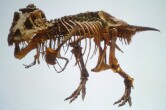Collagen Samples of Tyrannosaurus Rex Link Dinosaur to Birds
First time molecular data has solidified the evolutionary connection, researchers say.
|
E-mail this article
Subscribe to news
Printer friendly version
|

(SOURCES: Harvard University, news release, April 24, 2008)
THURSDAY, April 24 (HealthDay News) -- A molecular analysis of a 68-million-year-old sample of collagen protein from a Tyrannosaurus Rex confirms dinosaurs' evolutionary link to modern birds, according to U.S. scientists.
Collagen is the main protein of connective tissue in animals.
They said it's the first time that molecular data has been used to place a non-avian dinosaur in the phylogenetic tree that traces the evolution of species. The comparison of the T. rex protein revealed common ancestry with chickens, ostriches and, to a lesser extent, alligators.
While it's long been suspected that birds are dinosaurs' closest living relatives, that hypothesis rested largely on skeletal similarities.
"These results match predictions made from skeletal anatomy, providing the first molecular evidence for the evolutionary relationships of a non-avian dinosaur," study co-author Chris Organ, a postdoctoral researcher in organismic and evolutionary biology at Harvard University, said in a prepared statement.
"Even though we only had six peptides -- just 89 amino acids -- from T. rex, we were able to establish these relationships with a relatively high degree of support. With more data, we'd likely see the T. rex branch on the phylogenetic tree between alligators and chickens and ostriches, though we can't resolve this position with currently available data," Organ said.
The scrap of collagen protein came from a fossil T. rex femur (thigh bone) discovered in 2003 in a fossil-rich area that spans Montana and Wyoming.
Organ and colleague John M. Asara used sophisticated algorithms to compare collagen protein from several dozen species.
"Most of the collagen sequence was obtained from protein and genome databases, but we also needed to sequence some critical organisms, including modern alligator and modern ostrich, by mass spectrometry," Asara, director of the mass spectrometry core facility at Beth Israel Deaconess Medical Center and instructor in pathology at Harvard Medical School, said in a prepared statement.
"We determined that T. rex, in fact, grouped with birds -- ostrich and chicken -- better than any other organism we studied. We also show that it groups better with birds than modern reptiles, such as alligators and green anole lizards," Asara said.
The research was published in this week's issue of Science. The same team also reported that a similar analysis of 160,000- to 600,000-year-old collagen protein from mastodon bone shows a close evolutionary link between that extinct species and modern elephants.
More information
The University of California Museum of Paleontology has more about birds and dinosaurs. 
Copyright © 2008 ScoutNews, LLC. All rights reserved. 
HealthDayNews articles are derived from various sources and do not reflect federal policy. healthfinder.gov does not endorse opinions, products, or services that may appear in news stories. For more information on health topics in the news, visit the healthfinder.gov health library.